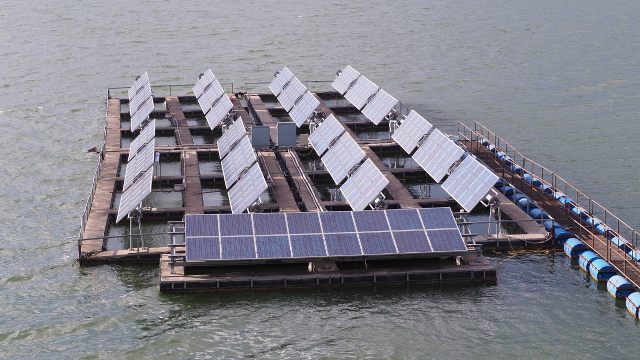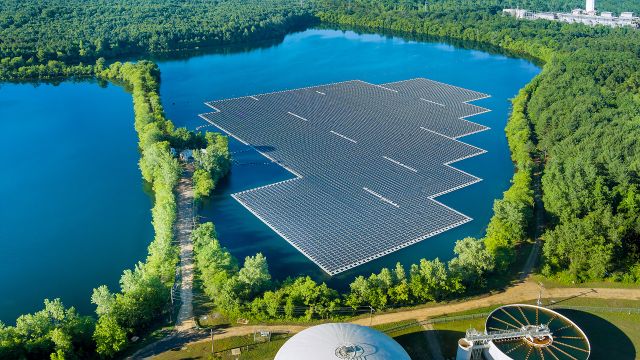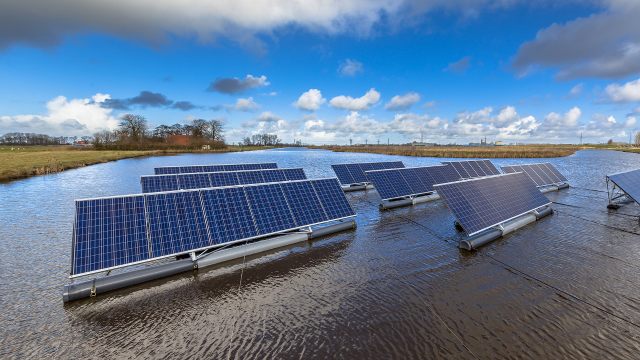Indian ambitions to reach a national goal of 100 GW of solar capacity by 2022 now include floating solar power projects. Reservoirs in India occupy 18,000 square kilometers and have the potential to produce 280 GW with floating solar panels, according to a report from the think tank The Energy and Resources Institute (TERI) published in 2020.
Page Contents
What is a floating solar plant?
A network of floating solar panels, also known as photovoltaics or floatovoltaics, is set on a structure designed to float on the surface of a body of water, such as a reservoir, lake, pond, or irrigation canal.

A floating solar plant typically includes a pontoon or floating platform, a mooring system to keep it anchored to the ground and prevent the panels from floating away, a photovoltaic system to produce electricity using thermal energy, and an underwater cable to connect the plant to a substation.
Development of the floating solar power technology
To combat climate change, more and more nations are converting to environmentally friendly ways of electricity production. In particular in nations with limited land, power generation technology using floating solar panels has proven to be an effective and quickly expanding method of sustainable energy.
Japan constructed the first floating photovoltaic system in 2007. The use was restricted to study and demonstration in a number of nations like the United States, France, Italy, and Spain that followed. The first commercial installation, albeit a small one, debuted in California in 2008, and other nations swiftly embraced renewable technology as a result. Floating solar capacity increased from 70 MW of peak electricity in 2015 to 1,300 MW in 2018, according to World Bank Group research. Globally, there will be around 300 floating solar projects by 2020. Global research firm Wood Mackenzie predicts that from 2019 to 2024, the demand for floating solar electricity would increase by 22% annually on average.

According to another report from the World Economic Forum from 2021, the installed capacity of floating solar power increased by more than a hundredfold in just five years to 2.6 gigawatts across 35 nations. The article continues, “If just 1% of the surface area of all man-made water bodies—which are generally less ecologically sensitive than natural lakes and easier to access—were covered by floating solar panels, it could generate 400 gigawatts—enough energy to run 44 billion LED light bulbs for a year.
The biggest floating solar farm in the world right now is in Shandong, China. The facility produces 320 MW per hour. Interestingly, China has created opportunities out of abandoned coal mines by constructing floating solar farms in flooded places. Singapore debuted a floating solar farm in 2021 that covered an area larger than 45 football fields. North Jeolla will become the site of a huge floating solar farm constructed by South Korea. Its capacity, which is anticipated to be 1,200 MW, will be equivalent to roughly 0.9% of the nation’s overall energy-producing capacity.
How is India implementing floating solar plant technology?
In order to access renewable energy sources, India started the National Solar Mission in 2010. A TERI study conducted in conjunction with the Energy Transmission Commission India programme found that as of 2019, floatovoltaic facilities with a capacity of 2.7 MW were in service, while more than 1.7 GW were in various stages of construction. By 2030, the government wants to have 500 GW of renewable energy installed.
The NTPC reported that it has already put into operation 222 MW of floating solar projects and had another 40 MW under construction as part of its goal to produce 60 GW of capacity from renewable sources by 2032. The NTPC has so far built floating solar plants on reservoirs in Simhadri in Andhra Pradesh and Kayamkulam in Kerala, totaling 92 MW (25 MW). On the Omkareshwar dam in the Khandwa district of Madhya Pradesh, the largest floating 600 MW solar energy project in the world is currently being built. It spans roughly 2000 hectares. Additionally approved were projects at Getalsud in Jharkhand, the Rihand reservoir in UP, and Vaitarna in Maharashtra.
The largest floating solar power installation in the country is located in Ramagundam, Telangana. The project, which cost Rs. 423 crores to build, covers 600 acres of the NTPC reservoir at Ramagundam.
According to a statement from the Ministry of Power, the 100 MW project was developed by BHEL under an EPC (Engineering, Procurement, and Construction) contract and makes use of cutting-edge technology and environmentally beneficial features. The floating solar installation is comprised of 40 blocks, each with a 2.5 MW capacity. One floating platform and an array of 11,200 solar modules make up each block. On floaters made of High-Density Polyethylene (HDPE), solar modules have been mounted. The project is unique since all of the electrical equipment is floating on Ferro-cement platforms with anchors made of deadweight concrete blocks, claims the official release. According to the NTPC, the 100MW project will save 2000 million liters of water annually, which is enough to cover the annual water needs of about 10,000 homes.
According to the Ministry of Power, Ramagundam can prevent 32.5 lakh cubic meters of water from evaporating each year. “The water body underneath the solar panels aids in controlling their ambient temperature, enhancing their productivity. Similar to how 1,65,000 tonnes of coal use may be reduced annually, 2,10,000 tonnes of CO2 emissions can be cut, according to the Ministry.
Are floating solar panel farms more effective?
According to a report by the International Energy Agency (IEA), solar power produces electricity at the lowest cost in history. Scientists believe that ground-mounted solar panels are difficult to perform at their full capacity since they heat up in addition to limitations related to land. Even though these farms are comparably more expensive, this is an area where floating solar technology has an advantage. The following are some benefits of floating solar power projects:

- Less use of land: Placing solar panels on rooftops or on the ground puts more strain on the land. Ground-mounted panels are not ideal for nations with a high population density and limited terrain. On the other hand, there is no requirement for land to create floating solar farms. A water body that is not currently being used can have a solar farm built on its surface.
- Higher Efficiency: Solar panels work more effectively when kept cool, much like any other electrical apparatus. The Environmental and Energy Study Institute claims that because of the cooling impact of the water beneath the panels, floating solar farms can be up to 15% more effective than those on the ground. Water acts as a coolant to keep solar panels at a constant temperature, which finally stops energy loss from higher temperatures. Additionally, since they are placed on the water’s surface, it is simple to clean them and move the network so that it faces the sun.
- Better for the environment: If properly planned and implemented, floating solar farms lessen the harm that climate change poses to water bodies. The WEF report claims that floating panels can delay climate change by 10 years. According to the 2020 report, “our results indicate that the fluctuations in ocean temperatures generated by floating solar farms could be as great as climate change itself, just in the other direction.” “A floating solar farm might counteract a decade of climate change warming by reducing wind speed and sun radiation by 10% across the entire lake. The designs that cooled the lake the most were those that shaded it more than protect it by limiting sunlight more than wind. The lake was mixed more often and evaporation decreased, which helps oxygenate the deeper water, according to the statement. Additionally, solar panels enhance the quality of the water by preventing algae growth in the water.
Are there any drawbacks of floating solar panel farms?
Experts are concerned about the long-term ecological impact on water ecosystems because the technology is so new. According to scientists, solar panels can obscure sunlight, which can harm aquatic life.
In its report titled “Where Sun Meets Water,” The World Bank lists some of these difficulties, including “the lack of a strong track record; uncertainty surrounding costs; uncertainty about predicting environmental impact; and the technical complexity of designing, building, and operating on and in water (especially electrical safety, anchoring and mooring issues, operation and maintenance).”
